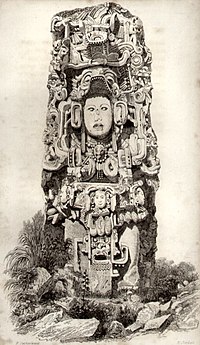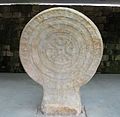Stele: Difference between revisions
→Gallery: file nominated for deletion |
wikification biznitch |
||
| Line 3: | Line 3: | ||
[[Image:CopanNSouthCatherwood.jpg|thumb|200px|Stela N from [[Copán]], [[Honduras]], depicting King K'ac Yipyaj Chan K'awiil ("Smoke Shell"), as drawn by [[Frederick Catherwood]] in 1839]] |
[[Image:CopanNSouthCatherwood.jpg|thumb|200px|Stela N from [[Copán]], [[Honduras]], depicting King K'ac Yipyaj Chan K'awiil ("Smoke Shell"), as drawn by [[Frederick Catherwood]] in 1839]] |
||
A '''stele''' ({{pron-en|ˈstiːliː}}, older {{IPA-en|ˈstiːl|}}, from [[Greek language|Greek]]: {{polytonic|στήλη}} ''stēlē''; plural: '''stelae''' {{IPA-en|ˈstiːlaɪ|}}, {{polytonic|στῆλαι}} ''stēlai''; also found: Latinised singular '''stela''' and Anglicised plural '''steles''') is a stone or wooden slab, generally taller than it is wide, erected for [[funerals]] or commemorative purposes, most usually decorated with the names and titles of the deceased or living — inscribed, carved in relief ([[bas-relief]], [[sunken-relief]], [[alto-relievo|high-relief]], and so forth), or painted onto the slab. |
A '''stele''' ({{pron-en|ˈstiːliː}}, older {{IPA-en|ˈstiːl|}}, from [[Greek language|Greek]]: {{polytonic|στήλη}} ''stēlē''; plural: '''stelae''' {{IPA-en|ˈstiːlaɪ|}}, {{polytonic|στῆλαι}} ''stēlai''; also found: Latinised singular '''stela''' and Anglicised plural '''steles''') is a stone or wooden slab, generally taller than it is wide, erected for [[funerals]] or [[memorial|commemorative purposes]], most usually decorated with the names and titles of the deceased or living — inscribed, carved in relief ([[bas-relief]], [[sunken-relief]], [[alto-relievo|high-relief]], and so forth), or painted onto the slab. |
||
==History and function== |
==History and function== |
||
Stelae were also used as territorial markers, as the boundary stelae of Akhenaton at [[Amarna]],<ref>''Memoirs'' By Egypt Exploration Society Archaeological Survey of Egypt 1908, p. |
Stelae were also used as territorial markers, as the boundary stelae of [[Akhenaton]] at [[Amarna]],<ref>''Memoirs'' By Egypt Exploration Society Archaeological Survey of Egypt 1908, p. |
||
19</ref> or to commemorate military victories.<ref>e.g., Piye's victory stela ([[M. Lichtheim]], |
19</ref> or to commemorate military victories.<ref>e.g., Piye's victory stela ([[M. Lichtheim]], |
||
''Ancient Egyptian Literature'' Vol 3, The University of California Press 1980, , pp.66ff) or Shalmaneser's stela at Saluria (Boardman, ''op.cit,'' p.335)</ref> They were widely used in the [[Ancient Near East]], [[Greece]], [[Egypt]], [[Ethiopia]], and, most likely independently, in [[China]] and some [[Buddhist]] cultures (see the [[Nestorian Stele]]), and, more surely independently, by [[Mesoamerican]] civilisations, notably the [[Olmec]]<ref>Pool, ''op.cit.'', p.265</ref> and [[Maya civilization|Maya]].<ref>Pool, ''op.cit.'', p.277</ref> The huge number of stelae surviving from [[ancient Egypt]] and in Central America constitute one of the largest and most significant sources of information on those civilisations. An informative stele of [[Tiglath-Pileser III]] is preserved in the [[British Museum]]. Two stelae built into the walls of a church are major documents relating to the [[Etruscan language]]. |
''Ancient Egyptian Literature'' Vol 3, The University of California Press 1980, , pp.66ff) or Shalmaneser's stela at Saluria (Boardman, ''op.cit,'' p.335)</ref> They were widely used in the [[Ancient Near East]], [[Greece]], [[Egypt]], [[Ethiopia]], and, most likely independently, in [[China]] and some [[Buddhist]] cultures (see the [[Nestorian Stele]]), and, more surely independently, by [[Mesoamerican]] civilisations, notably the [[Olmec]]<ref>Pool, ''op.cit.'', p.265</ref> and [[Maya civilization|Maya]].<ref>Pool, ''op.cit.'', p.277</ref> The huge number of stelae surviving from [[ancient Egypt]] and in Central America constitute one of the largest and most significant sources of information on those civilisations. An informative stele of [[Tiglath-Pileser III]] is preserved in the [[British Museum]]. Two stelae built into the walls of a church are major documents relating to the [[Etruscan language]]. |
||
Revision as of 07:02, 28 May 2009

A stele (Template:Pron-en, older /ˈstiːl/, from Greek: στήλη stēlē; plural: stelae /ˈstiːlaɪ/, στῆλαι stēlai; also found: Latinised singular stela and Anglicised plural steles) is a stone or wooden slab, generally taller than it is wide, erected for funerals or commemorative purposes, most usually decorated with the names and titles of the deceased or living — inscribed, carved in relief (bas-relief, sunken-relief, high-relief, and so forth), or painted onto the slab.
History and function
Stelae were also used as territorial markers, as the boundary stelae of Akhenaton at Amarna,[1] or to commemorate military victories.[2] They were widely used in the Ancient Near East, Greece, Egypt, Ethiopia, and, most likely independently, in China and some Buddhist cultures (see the Nestorian Stele), and, more surely independently, by Mesoamerican civilisations, notably the Olmec[3] and Maya.[4] The huge number of stelae surviving from ancient Egypt and in Central America constitute one of the largest and most significant sources of information on those civilisations. An informative stele of Tiglath-Pileser III is preserved in the British Museum. Two stelae built into the walls of a church are major documents relating to the Etruscan language.
The erection of steles was popular in China and consisted of rectangular stone tablets usually inscribed with a funerary, commemorative, or edifying text. Although the earliest steles, inspired by Buddhists, date to the first half of the fifth century this visual form did not come into general use until the last years of the fifth century, and this custom prevailed until the end of the sixth century. From then on the design of steles drifted away from pure Buddhist influence and became wordy displays of script mostly eulogistic or commemorative. They were placed in front of tombs to announce the name of the person buried there, often to provide details of the deceased’s life, or were provided to commemorate a particular incident or event and to give details of the purpose of the occasion. Erecting steles at tombs or temples eventually became a widespread social and religious phenomenon.
Thousands of steles, surplus to the original requirements, and no longer associated with the person they were erected for, have been assembled in Xian and the display has become a popular tourist attraction. Many unwanted steles can also be found in selected places in Beijing, such as Dong Yue Miao, the Five Pagoda Temple, and the Bell Tower, again assembled to attract tourists and also as a means of solving the problem faced by local authorities of what to do with them. The long, wordy, and detailed inscriptions on these steles are almost impossible to read for most are lightly engraved on white marble in characters only an inch or so in size, thus being difficult to see since the slabs are often ten or more feet tall. Very seldom are the inscriptions memorable or of any interest.
In 1489, 1512, and 1663 CE, the Kaifeng Jews of China left these stone monuments to preserve their origin and history. Despite repeated flooding of the Yellow River, destroying their synagogue time and time again, these stelae survived to tell their tale.
Unfinished standing stones, set up without inscriptions from Libya in North Africa to Scotland were monuments of pre-literate Megalithic cultures in the Late Stone Age. The Pictish stones of Scotland, often intricately carved, date from between the 6th and 9th centuries.
An obelisk is a specialized kind of stele. The Insular high crosses of Ireland and Britain are specialized stelae. Likewise, the Totem pole of North and South America is a type of stelae. Gravestones with inscribed epitaph are also kinds of stelae.
Most recently, in the Memorial to the Murdered Jews of Europe in Berlin, the architect Peter Eisenman created a field of some 2,700 blank stelae.[5] The memorial is meant to be read not only as the field, but also as an erasure of data that refer to memory of the Holocaust.
Notable individual stelae
- Axumite Stele
- Stele of Naram-Sin
- Code of Hammurabi
- Gwanggaeto Stele
- Nestorian Stele
- Ukrainian stone stela
- Lemnos stela
- Lapis Niger
- For Israel/Egypt:
- For Egypt:
- In the Western Hemisphere:
- Peru: Raimondi Stela
- Mexico: Stela C at Tres Zapotes
- Mexico: Izapa Stela 5
- Mexico: La Mojarra Stela 1
- Guatemala: Stela 14 from Piedras Negras
- Honduras: Stela H from Copan
Gallery
This section contains an unencyclopedic or excessive gallery of images. |
-
Ancient Egyptian funerary stele
-
The Rosetta Stone in the British Museum
-
3-D view of Rosetta Stone-Left side
-
Scythian 5th–4th c.BC. Salbyk kurgan surrounded by balbals with kurgan obelisk on the top. Upper Enisey-Irtysh interfluvial
An editor has nominated the above file for discussion of its purpose and/or potential deletion. You are welcome to participate in the discussion and help reach a consensus. -
1517 Shaolin stele dedicated to the mythical legend of Vajrapani's defeat of the Red Turban rebels. The Bodhisattva Guanyin (his original form) can be seen in the clouds above his head.[6]
See also
- Inscription
- Stele Forest, in Xi'an, China
- Runestone
- Monumental inscription
- Hilarri or Basque steles
- Stećci
Bibliography
- John Boardman ed., The Cambridge Ancient History, Part 1, 2nd Edition, (ISBN 9780521224963 | ISBN 0521224969)
- Christopher A. Pool, Olmec Archaeology and Early Mesoamerica, Cambridge University Press 2007 (ISBN 9780521783125)
- Karen E. Till, The New Berlin: Memory, Politics, Place, University of Minnesota Press 2005
Footnotes and references
- ^ Memoirs By Egypt Exploration Society Archaeological Survey of Egypt 1908, p. 19
- ^ e.g., Piye's victory stela (M. Lichtheim, Ancient Egyptian Literature Vol 3, The University of California Press 1980, , pp.66ff) or Shalmaneser's stela at Saluria (Boardman, op.cit, p.335)
- ^ Pool, op.cit., p.265
- ^ Pool, op.cit., p.277
- ^ Till, op.cit., p.168
- ^ Shahar, Meir. The Shaolin Monastery: History, Religion, and the Chinese Martial Arts. Honolulu: University of Hawai'i Press, 2008 (ISBN 0824831101), pp. 35-36









![1517 Shaolin stele dedicated to the mythical legend of Vajrapani's defeat of the Red Turban rebels. The Bodhisattva Guanyin (his original form) can be seen in the clouds above his head.[6]](http://upload.wikimedia.org/wikipedia/en/thumb/0/0c/Shaolinstele.jpg/99px-Shaolinstele.jpg)